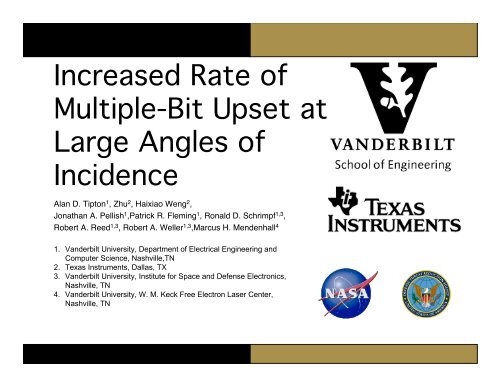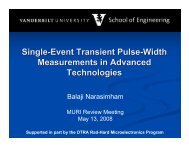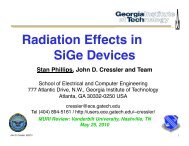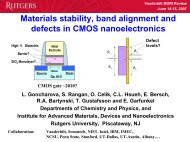Increased Rate of Multiple-Bit Upset at Large Angles of Incidence
Increased Rate of Multiple-Bit Upset at Large Angles of Incidence
Increased Rate of Multiple-Bit Upset at Large Angles of Incidence
Create successful ePaper yourself
Turn your PDF publications into a flip-book with our unique Google optimized e-Paper software.
<strong>Increased</strong> <strong>R<strong>at</strong>e</strong> <strong>of</strong><strong>Multiple</strong>-<strong>Bit</strong> <strong>Upset</strong> <strong>at</strong><strong>Large</strong> <strong>Angles</strong> <strong>of</strong><strong>Incidence</strong>Alan D. Tipton 1 , Zhu 2 , Haixiao Weng 2 ,Jon<strong>at</strong>han A. Pellish 1 ,P<strong>at</strong>rick R. Fleming 1 , Ronald D. Schrimpf 1,3 ,Robert A. Reed 1,3 , Robert A. Weller 1,3 ,Marcus H. Mendenhall 41. Vanderbilt University, Department <strong>of</strong> Electrical Engineering andComputer Science, Nashville,TN2. Texas Instruments, Dallas, TX3. Vanderbilt University, Institute for Space and Defense Electronics,Nashville, TN4. Vanderbilt University, W. M. Keck Free Electron Laser Center,Nashville, TN
OutlineBackground<strong>Multiple</strong>-bit upset (MBU)Neutron-induced MBUExperimentalSingle-bit<strong>Multiple</strong>-bitModelingMonte-Carlo Radi<strong>at</strong>ive Energy Deposition (MRED)SummaryFuture workAlan Douglas TiptonNASA Review2
BackgroundExperimentalModelingSummary<strong>Multiple</strong>-bit upsetNeutron-induced upsets<strong>Multiple</strong>-bit upset increases with scalingMaiz et al.Tosaka et al.Kawakami et al.Hubert et al.from Seifert, et al., IRPS, 2006.<strong>Multiple</strong>-bit upset (MBU) increases for smaller technologiesFe<strong>at</strong>ure size small rel<strong>at</strong>ive to radi<strong>at</strong>ion eventsMBU 2 or more physically adjacent bitsAlan Douglas TiptonNASA Review3
Secondary products induce s<strong>of</strong>t errorsNuclearReactionBackgroundExperimentalModelingSummary<strong>Multiple</strong>-bit upsetNeutron-induced upsetsIncidentNeutronHeavy-IonNeutron-induced nuclear reactionsSensitiveNodesAlan Douglas TiptonNASA Review4
BackgroundExperimentalModelingSummaryDevice under test is a TI 90 nm SRAMTI 90nm CMOS high performance (C027)DSP embedded SRAM (8MEG) @ 1.2 VLANL WNR Neutron beam lineDevice under testSingle-bit<strong>Multiple</strong>-bitMultiplicityTest conditions - 0°, 45°, 90°, & 180°Alan Douglas TiptonNASA Review5
BackgroundExperimentalModelingSummaryDevice under testSingle-bit<strong>Multiple</strong>-bitMultiplicitySingle-bit r<strong>at</strong>e is not angle dependentNo angular dependenceAlan Douglas TiptonNASA Review6
BackgroundExperimentalModelingSummaryDevice under testSingle-bit<strong>Multiple</strong>-bitMultiplicityMBU multiplicity is higher <strong>at</strong> large angles<strong>Large</strong> angles show most number <strong>of</strong> MBU events<strong>Large</strong> angles show largest MBU eventsAlan Douglas TiptonNASA Review8
Modeling methodologyTI 90 nm SRAM modelSensitive nodeCharge collectionvolumeTechnology ComputerAided Design (TCAD)ModelSimul<strong>at</strong>ion - MRED(Monte-Carlo Radi<strong>at</strong>iveEnergy Deposition) CodeSingle bit<strong>Multiple</strong> bitBackgroundExperimentalModelingSummaryMethodologySingle-bit<strong>Multiple</strong>-bitNeutronSpectrumSensitiveNodeSBUTCADMREDMetalliz<strong>at</strong>ionMBUAlan Douglas TiptonNASA Review9
BackgroundExperimentalModelingSummaryMethodologySingle-bit<strong>Multiple</strong>-bitMRED simul<strong>at</strong>ed the TCAD deviceTCAD structure cre<strong>at</strong>ed from TI layout and processDevice simul<strong>at</strong>ed using LANL beam line neutron spectrumCopperlinesTungstenviasAlan Douglas TiptonSiliconbulkSingleCellNASA Review10
LANL neutron beamBackgroundExperimentalModelingSummaryMethodologySingle-bit<strong>Multiple</strong>-bitWNR beam spectrum imported into MREDFluence comparable to cosmic-ray neutron fluenceAlan Douglas TiptonNASA Review11
BackgroundExperimentalModelingSummaryMethodologySingle-bit<strong>Multiple</strong>-bitMRED simul<strong>at</strong>es ioniz<strong>at</strong>ion and nuclear processesSensitiveNodesCell Arrayn+Si→C+3n+2p + +3αMRED tracks energy deposition through all layersMRED calcul<strong>at</strong>es energy deposition <strong>at</strong> each nodeαAlan Douglas TiptonNASA Review12
BackgroundExperimentalModelingSummaryMethodologySingle-bit<strong>Multiple</strong>-bitSingle-bit r<strong>at</strong>e does not depend on orient<strong>at</strong>ion90°45°0°No angle dependenceNo frontside-backside dependenceAlan Douglas TiptonNASA Review13
BackgroundExperimentalModelingSummaryMethodologySingle-bit<strong>Multiple</strong>-bitSingle-bit simul<strong>at</strong>ion in good agreementCircuit simul<strong>at</strong>ion suggest Q crit = 4 fCSimul<strong>at</strong>ion in agreement with experimental d<strong>at</strong>a <strong>at</strong> Q CritAlan Douglas TiptonNASA Review14
BackgroundExperimentalModelingSummaryMethodologySingle-bit<strong>Multiple</strong>-bit<strong>Multiple</strong>-bit probability depends on orient<strong>at</strong>ion90°45°0°Preferential direction from spacing and nuclear productsAlan Douglas TiptonNASA Review15
BackgroundExperimentalModelingSummary<strong>Multiple</strong>-bit upset probabilityMethodologySingle-bit<strong>Multiple</strong>-bitSimul<strong>at</strong>ion shows increased probability <strong>at</strong> grazing anglesMore calibr<strong>at</strong>ion needed <strong>at</strong> 90ºAlan Douglas TiptonNASA Review16
ConclusionsBackgroundExperimentalModelingSummaryConclusionsPublic<strong>at</strong>ions and talksFuture work<strong>Multiple</strong>-bit upset is increasing for highly-scaled devicesNeutron irradi<strong>at</strong>ion has been modeled using MRED for a TI90 nm CMOS technologySBU independent <strong>of</strong> device orient<strong>at</strong>ionProbability <strong>of</strong> MBU exhibits an angle dependence forneutron irradi<strong>at</strong>ionProbability increases <strong>at</strong> grazing anglesNeutron testing must account for these dependenciesAlan Douglas TiptonNASA Review17
Public<strong>at</strong>ions and talksBackgroundExperimentalModelingSummaryConclusionsPublic<strong>at</strong>ions and talksFuture workA. D. Tipton, J. A. Pellish, P. R. Fleming, R. D. Schrimpf, R.A. Reed, R. A. Weller, M. H. Mendenhall, and L. W.Massengill, "High-energy neutron multiple-bit upset,"presented <strong>at</strong> Intern<strong>at</strong>ional Conference on IC Design andTechnology, Austin, TX, 2007.A. D. Tipton, X. Zhu, H. Weng, J. A. Pellish, P. R. Fleming,R. D. Schrimpf, R. A. Reed, R. A. Weller, and M.Mendenhall, "<strong>Increased</strong> r<strong>at</strong>e <strong>of</strong> multiple-bit upset <strong>at</strong> largeangles <strong>of</strong> incidence," IEEE Trans. Dev. M<strong>at</strong>. and Rel.,submitted for review.Alan Douglas TiptonNASA Review18
Future workBackgroundExperimentalModelingSummaryConclusionsPublic<strong>at</strong>ions and TalksFuture workTI 65 nm processDevice simul<strong>at</strong>ion <strong>of</strong> SRAM cellNASA-GSFC/Vanderbilt proton and heavy-ion testingExamine impact <strong>of</strong> angular dependence on error r<strong>at</strong>eProton effectsProton-induce SEEProton-induced MBUPossible IBM collabor<strong>at</strong>ionProton ioniz<strong>at</strong>ionDissert<strong>at</strong>ion Fall ʻ08Alan Douglas TiptonNASA Review19





